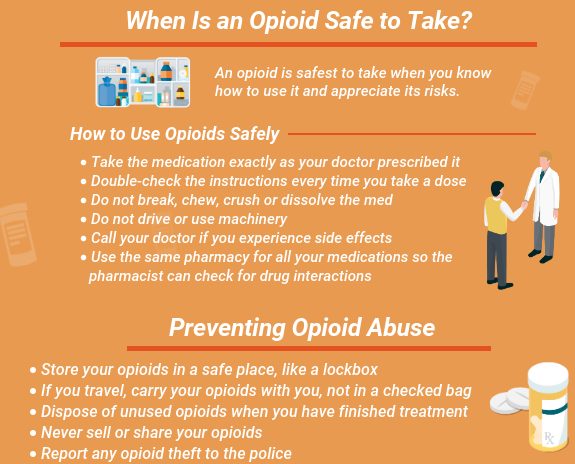Even if you take an opioid prescription exactly as prescribed, addiction is possible.
With the opioid epidemic now in full swing across the country, more than 130 people die every day from opioid overdose. Because opioids remain commonly prescribed pain medications, this has led people to realize that opioid addiction is possible, even if a person uses opioids as prescribed.
A recent poll conducted by The Recovery Village explored attitudes about the ease of becoming addicted to opioids.
| Number of Participants: | 400 |
|---|---|
| Age: | 18 to 34: 40% of participants 35 to 54: 37% of participants 55 and older: 23% of participants |
| Gender: | Female: 60% Male: 40% |
| Ethnicity: | White: 67% Black: 11% Hispanic: 11% Asian: 6% |
| Marital Status: | Married: 39% Single: 38% |
| Income: | Low-Income: 59% Middle-Income: 25% High-Income: 10% |
How Opioid Addiction Develops
Opioids are drugs that not only relieve pain and impact the brain’s powerful reward center. When you take an opioid, your brain is flooded with feel-good chemicals. The more opioids you take, the less of these feel-good chemicals your body produces on its own. Over time, the body grows dependent on opioids to feel good. Worse still, as your brain becomes used to the opioids, you may gradually need higher doses to obtain the same feel-good effects. Together, these factors can lead to someone starting to feel like they need to take opioids to feel normal. In other words, the person starts to become addicted.
Opioids have been around for hundreds of years. However, the abuse of prescription opioids in their current form didn’t become a public health crisis until the early 2000s. Several factors came together to create this perfect storm.
Starting in the 1990s and 2000s, many influential groups pushed for policies that increased opioid prescribing.
- In 1990, a doctor from the National Institute of Health wrote an article in an influential medical journal, the Annals of Internal Medicine, where he advocated for widespread pain treatment and claimed that opioids were not addictive when used for pain. Slowly, this view started to become accepted in the medical community.
- In 1996, after the drug company Purdue Pharma came out with the opioid OxyContin, their marketing campaigns and sales representatives downplayed the risk of addiction associated with OxyContin
- In 1997, the Drug Enforcement Administration and state medical boards declared their support for patient access to opioids. Doctors took note and began prescribing opioid medications more frequently.
- In 2000, the Joint Commission, which accredits hospitals, developed standards for treating pain. If doctors could not show that they were adequately treating pain, their hospitals would fail to meet these standards and might lose funding. Experts believe that the Joint Commission standards were a major factor in convincing hospitals and doctors to prescribe more opioids.
Overprescribing Is a Key Component
When asked to identify the main driving factor for the opioid crisis in the United States, almost 64% of Recovery Village poll respondents stated that they believed that overprescribing was the main culprit.
Experts agree with the poll respondents. Research shows that opioid overprescribing is widespread and plays a major role in opioid addiction. In many cases, doctors end up prescribing more pills than necessary. The greater the number of pills prescribed, the greater the chance they are taken for longer than necessary, which increases the risk of addiction. Often, medications prescribed for acute pain end up being taken long-term. For example, around 6% of people who begin taking opioids after minor or major surgeries continue using the drugs 90 days after surgery. Prolonged opioid use greatly increases the risk of addiction. Up to 26% of people who are prescribed opioids for chronic, non-cancer-related pain end up becoming dependent on the drugs.
When Is an Opioid Safe to Take?
Most poll respondents were concerned about the safety of using opioids even when taken as prescribed.
When asked if opioids are addictive even if used as directed, almost 60% of respondents said, “yes.”
Respondents are correct that opioids are addictive, and that the benefits of using them need to be carefully weighed against the risks. Opioids are safest to take when you know how to use it and appreciate its risks. Generally, the lowest possible dose should be used for the shortest amount of time.

Opioids are not the only therapy used to treat pain. Non-opioid medications and therapies are also available. Because opioids are a high-risk drug, talking with your doctor about first trying other options is important.
Before taking an opioid, be sure to discuss the risks of opioid use with your doctor or pharmacist so that you fully understand:
- How much of the medication to take
- What results to expect from taking the medication
- How often to take the medication
- The medication’s side effects
- When to follow up with your doctor
- How long you should take the medication
- How to stop taking the medication
Points to discuss with your doctor are:
- Alternative pain-relieving options
- The benefit of taking opioids compared to the risk
- If you or anyone in your family has a history of addiction
- Other medications you are taking
- How much alcohol you drink
- If you are pregnant or could become pregnant
You should also discuss the warning signs of addiction with your doctor or pharmacist. If you know what factors to be aware of, you may notice them more quickly. This can help to stop addiction before it has a chance to start. Some of the warning signs of opioid addiction include are:
- Taking more of the medication than prescribed
- Taking opioids that belong to someone else
- Using the medication for reasons other than prescribed, like to get high or fall asleep
- Mood swings
If you or a loved one has been prescribed an opioid, tips for safe use include:
- Take the medication exactly as your doctor prescribed it, with no extra doses
- Double-check the instructions every time you take a dose
- Do not break, chew, crush or dissolve the med, as this can alter how fast it gets into your system
- Do not drive or use machinery, especially if you have just started the medication or changed doses
- Call your doctor if you experience side effects
- Use the same pharmacy for all your medications so the pharmacist can check for drug interactions
Ask your doctor or pharmacist for the opioid reversal drug naloxone, and learn how to use it in case of overdose
Because opioids are so prone to abuse, it is important to take steps to prevent abuse. Steps to take include:
- Store your opioids in a safe place, like a lockbox
- If you travel, carry your opioids with you instead of bringing them in a checked bag
- Dispose of unused opioids when you have finished treatment. Your pharmacist or local police station will be able to give you more information on how to do this with your specific prescription.
- Never sell or share your opioids
- Report any opioid theft to the police
If you or someone you love shows signs of opioid addiction, they may need help to break free of the cycle of opioid use. Our experts at The Recovery Village can help put them on the path to a healthier future. Contact us today to learn more.


National Institute on Drug Abuse. “Opioid Overdose Crisis.” January 2019. Accessed August 25, 2019.
U.S. National Library of Medicine. “Safe Opioid Use.” April 30, 2019. Accessed August 25, 2019.
Frieden, Thomas R.; Houry, Debra. “Reducing the Risks of Relief — The CDC Opioid-Prescribing Guideline.” New England Journal of Medicine, April 21, 2016. Accessed August 25, 2019.
Brummett, Chad M; et al. “New Persistent Opioid Use After Minor an[…]cedures in US Adults.” Journal of the American Medical Association, June 21, 2017. Accessed August 25, 2019.
Cimino, Steve. “Overprescribing Opioids Leads to Higher […]evels of Consumption.” The Hospitalist, November 27, 2018. Accessed August 25, 2019.
Joranson, David E; et al. “Pain Management, Controlled Substances, and State Medical Board Policy.” Journal of Pain and Symptom Management, February 2002. Accessed August 25, 2019.
Van Zee, Art. “The Promotion and Marketing of OxyContin[…]ublic Health Tragedy.” American Journal of Public Health, February 2009. Accessed August 25, 2019.
Jones, Mark R; et al. “A Brief History of the Opioid Epidemic a[…]es for Pain Medicine.” Pain and Therapy, April 24, 2018. Accessed August 25, 2019
The Recovery Village aims to improve the quality of life for people struggling with substance use or mental health disorder with fact-based content about the nature of behavioral health conditions, treatment options and their related outcomes. We publish material that is researched, cited, edited and reviewed by licensed medical professionals. The information we provide is not intended to be a substitute for professional medical advice, diagnosis or treatment. It should not be used in place of the advice of your physician or other qualified healthcare providers.